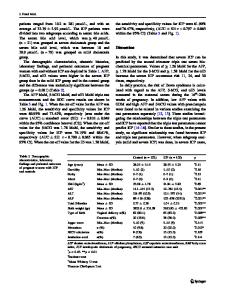Can Biomethane Potential (BMP) Be Predicted from Other Variables Such As Biochemical Composition in Lignocellulosic Biom
- PDF / 606,811 Bytes
- 14 Pages / 595.276 x 790.866 pts Page_size
- 95 Downloads / 298 Views
Can Biomethane Potential (BMP) Be Predicted from Other Variables Such As Biochemical Composition in Lignocellulosic Biomass and Related Organic Residues? Rémy Bayard 1 & Xun Liu 1 & Hassen Benbelkacem 1 & Pierre Buffiere 1 & Rémy Gourdon 1
# Springer Science+Business Media New York 2015
Abstract The potential of methane production by anaerobic digestion of lignocellulosic biomass depends not only on the availability of the resources in the considered territory, but also on their physico-chemical characteristics. Relevant methods of characterization are, therefore, needed to select and possibly combine the most appropriate biomass substrates in order to optimize energy recovery through anaerobic digestion processes. The objective of the present study was to determine whether biomethane potential of such substrates could be predicted from a limited number of variables more rapidly or determined more easily. A set of 36 biomass substrates and organic residues from a variety of origins was analyzed for total and easily hydrosoluble organic matter fractions (volatile solid, VS and soluble chemical oxygen demand, SCOD), neutral detergent soluble fraction (SOL), hemicelluloses (HEM), cellulose (CELL), and lignin-like residual fractions (RES). Bioreactivity of all samples was also measured by experimental assays (biochemical oxygen demand, BOD and biochemical methane potential, BMP). The whole set of data thereby
Highlights • Biomethane potential (BMP) and biological oxygen demand (BOD) were both anti-correlated with Van Soest’s residual fraction (RES). • For substrates representative of the large ranges of biochemical compositions, no clear correlations were observed between BMP, soluble COD (SCOD), hemicellulose (HEM), and (CELL) contents. • The most influential variables to predict BMP were found to be RES and BOD. • A polynomial model was successfully validated for the prediction of BMP from RES and BOD. * Rémy Bayard [email protected] 1
Université de Lyon, INSA Lyon, LGCIE-DEEP, EA4126, 69621 Villeurbanne cedex, France
obtained was analyzed statistically considering one dependent variable (BMP), and six independent variables (SCOD, SOL, HEM, CELL, RES, and BOD). Partial least square (PLS) analysis revealed very clearly a positive correlation between BMP and BOD, which were both anti-correlated with RES. On the other hand, no correlations were observed between BMP, SCOD, HEM, and CELL contents. PLS analysis showed that BMP was significantly correlated to the six independent variables. The most influential variables were found to be RES and BOD, and a polynomial model was successfully validated for the prediction of BMP from RES and BOD. Keywords Biochemical methane potential . Biodegradation . Anaerobic digestion . Biomass . Organic waste . Lignocellulose . Cellulose . Lignin . Correlation . Statistical analysis
Abbreviations AD Anaerobic digestion BDAero Bioconversion yield under aerobic condition Bioconversion yield under anaerobic condition BDAnae BOD Biological oxygen demand after 28 days of incubation
Data Loading...










